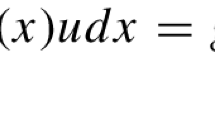Summary
There are some flows in which certain strain components grow exponentially in time, while there are other flows in which the components depend otherwise on the time. In this paper the former type are called strong flows and the latter weak. An examination of theJordan form of the matrix of the velocity gradient of a steady, homogeneous, isochoric flow is made, along with the eigenvalues of such a matrix, to discover when such a flow is strong or weak. It is shown that if the eigenvalues are all zero or if one is zero and the other two purely imaginary, then the flow is weak, with the remaining cases leading to strong flows.
Zusammenfassung
Es gibt Strömungen, in denen gewisse Deformationskomponenten exponentiell mit der Zeit anwachsen, und es gibt solche, in denen die Zeitabhängigkeit der Deformationskomponenten eine andere mathematische Form aufweist. In dieser Abhandlung sind die ersteren alsstarke Strömungen und die letztgenannten alsschwache Strömungen bezeichnet. Eine Untersuchung derJordanschen Form der Matrix des Geschwindigkeitsgradienten einer stationären, homogenen Strömung, zusammen mit den Eigenwerten einer solchen Matrix, erlaubt zu bestimmen, ob die Strömung stark oder schwach ist. Es wird gezeigt, daß die Strömung schwach ist, wenn entweder alle Eigenwerte verschwinden oder aber wenn ein Eigenwert verschwindet und die beiden anderen rein imaginär sind. Alle übrigbleibenden Fälle entsprechen starken Strömungen.
Similar content being viewed by others
References
Giesekus, H. Rheol. Acta2, 101 (1962).
Giesekus, H. Rheol. Acta2, 113 (1962).
Lodge, A. S., Elastic Liquids, p. 101 (New York, 1964).
Noll, W. Arch. Ratl. Mech. Anal.11, 97 (1962).
Tanner, R. I. andW. Stehrenberger J. Chem. Phys.55, 1958 (1971).
Tanner, R. I. Trans. Soc. Rheol.19, 37 (1975).
Tanner, R. I., Progress in Experimental Rheology, Lecture to British Society of Rheology, September, 1974 (to be published).
Huilgol, R. R. Trans. Soc. Rheol. 19, 297 (1975).
Huilgol, R. R. Quart. Appl. Math.29, 1 (1971).
Coleman, B. D. Arch. Ratl. Mech. Anal.9, 273 (1962).
Coleman, B. D. andW. Noll Phys. Fluids5, 840 (1962).
Huilgol, R. R. Trans. Soc. Rheol.13, 513 (1959).
Huilgol, R. R. Rheol. Acta14, 48 (1975).
Hildebrand, F. B., Methods of Applied Mathematics. Second Edition, p. 111 (1965).
Martin, A. D. andV. J. Mizel, Introduction to Linear Algebra, p. 415 (New York, 1966).
Author information
Authors and Affiliations
Rights and permissions
About this article
Cite this article
Tanner, R.I., Huilgol, R.R. On a classification scheme for flow fields. Rheol Acta 14, 959–962 (1975). https://doi.org/10.1007/BF01516297
Received:
Published:
Issue Date:
DOI: https://doi.org/10.1007/BF01516297




